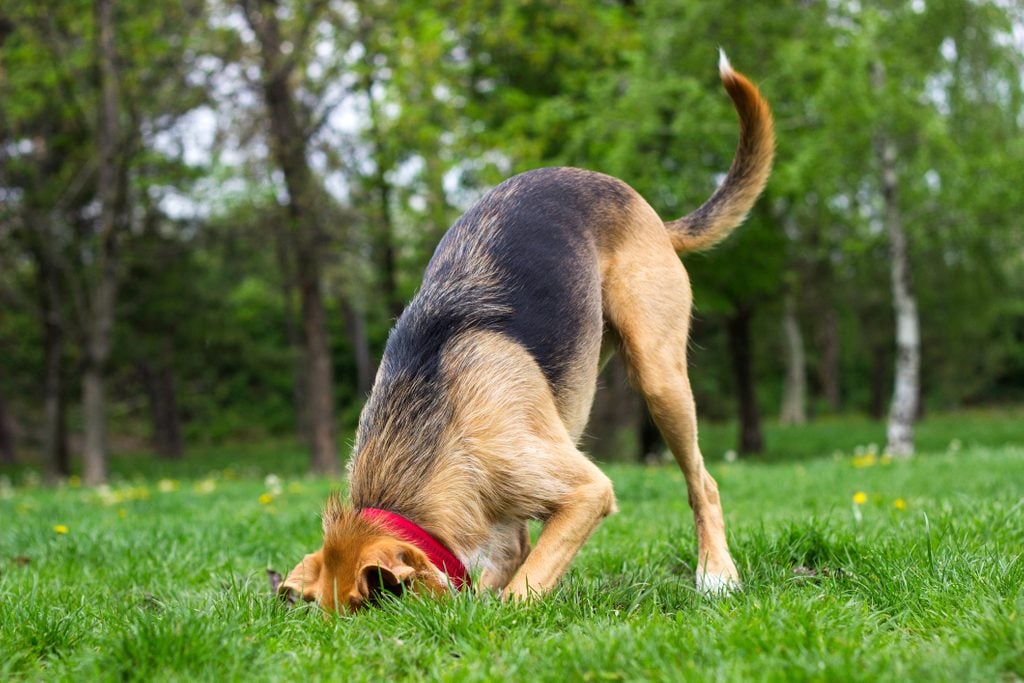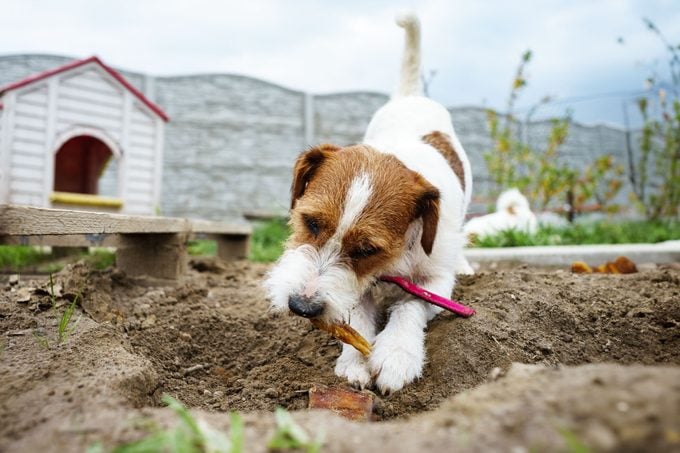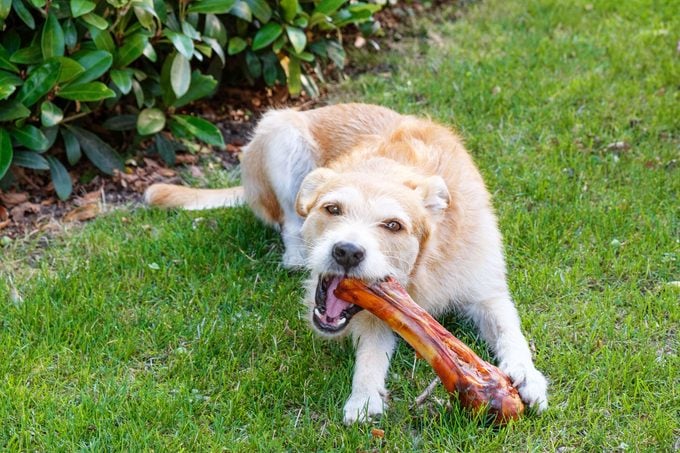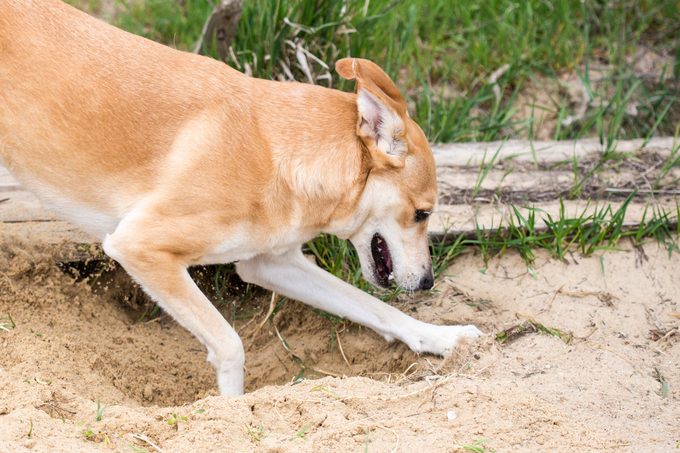Why Do Dogs Bury Bones?
Updated: Mar. 26, 2024

Does your dog bury bones in the yard or hide treats and toys under your pillow? Here, experts explain the reasons why dogs like to bury bones.
Many dog owners have backyards that look like they’ve suffered a gopher invasion. But it’s not rodents to blame—it’s the dog. It may be stereotypical, but dogs do bury bones and other goodies all the time. And if it’s not in the yard, it’s somewhere in the house, such as under a pile of blankets. When he was younger, my Chihuahua used to leave all kinds of presents hidden in the bed. I never knew what I’d find under my pillow.
Dog behavior can seem odd to us. After all, they live in our homes and even wear adorable sweaters, but they are animals with a wild history. In more than 13 years as a certified professional dog trainer (CPDT-KSA), I’ve had loads of exasperated clients request advice on how to stop a dog’s digging habit and ask me, “Why do dogs bury bones?” Understanding why they bury perfectly good bones and other treats or toys is confusing. Why hide something you love?
Let’s explore the reasons for this common dog behavior and how you can address it.
Get Reader’s Digest‘s Read Up newsletter for pet insights, humor, cleaning, travel, tech and fun facts all week long.
About the experts
Reviewed for accuracy by: Wailani Sung, DVM, a vet with a board certification in veterinary behavioral medicine who owns Bay Area Vet Behavior. Dr. Sung is the co-author of From Fearful to Free: A Positive Program to Free Your Dog from Anxiety, Fears and Phobias. |
Why do dogs bury bones?

Remember that dogs didn’t always live in houses or apartments. In fact, they were once wild animals and share a common ancestor with gray wolves. Much of what they do today can be explained by looking at that heritage, and burying bones is no exception. Before they got their food in fancy bowls, dogs hunted for their dinner, and there was competition for those meals. So let’s look at some of the reasons why dogs bury bones.
It’s an instinct
Many canid species cache their food, meaning they dig a hole and bury food in it for later. But what purpose does that serve? A study in Behavioural Processes that looked at caching in red foxes, coyotes and gray wolves states that “food caching gives animals a biological advantage over non-cachers, as it allows for the control over the availability of food in harsh or changing environments.” In other words, animals that bury their food for later are playing it safe in case of a proverbial rainy day.
And as dogs evolved from a wolf ancestor, they play it safe too, whether they are free-roaming or living as pets. Rachel Lane is a certified behavior consultant, dog trainer and the owner of the dog-training company Leash & Learn. She says burying food like bones is rooted in a dog’s genetics and may have once been essential for survival, as it serves as an advantage in case of a food shortage. “Even though most companion dogs do not experience a lack of food, they still may bury their bones and other resources because it is instinctual,” she says.
So if it’s an instinct, is it equally strong in every dog? The connection to ancestral roots may seem obvious in wolflike dogs such as huskies or German shepherds, but do dogs like pugs and bulldogs dig and bury too? According to celebrity dog trainer Nicole Ellis, dogs that are bred to hunt and chase are the ones that most often bury things. However, digging is an innate desire of many dogs. “Some dogs may simply enjoy the act of digging without the act of hiding something,” she says.
Indeed, any dog may hide or bury items, even if it’s not typical for the breed. A recent study in Science looked at how dog genetics align with breed characteristics. The researchers discovered that greyhounds weren’t big on burying their toys. In fact, 90% of the greyhounds in the study never performed that behavior. However, three of the greyhound subjects were described by their owners as “frequent buriers.” So even when you might not expect it, a dog can love digging and burying bones.
It keeps their food fresh

It’s obvious a buried bone is hidden safely for later, but will it be any good when the dog returns to enjoy it? After all, it will be covered in dirt. Ellis says burying meat in the soil is actually a way of preserving it because it won’t go rancid as quickly as it would if it was left sitting in the hot sun. No wonder that instinct to cache is so strong.
But dogs will bury items even inside the house. If you have one of those pets, you’ve probably wondered, Why does my dog hide his treats under my pillow? It’s the same caching behavior. Lane says that when your dog can’t get outside to bury a beloved object, it will do so inside instead. “Burying toys, bones and treats under pillows or blankets serves the same function as burying these items in the dirt–it’s to save them for later and to prevent predators and competitors from accessing them,” she says.
Whether it’s inside or outside, do dogs remember where they buried their bones? Or are they just sniffing for them with their superior sense of smell? Of course, dogs can find hidden food by smell alone, but veterinary psychiatrist Sagi Denenberg, DVM, a diplomate of the American College of Veterinary Behavior, says dogs remember where objects are hidden too. “We know they also use memory because tests show that even if other areas are smell-baited, they still choose based on memory,” he says.
In fact, a recent study in PLOS ONE discovered that both wolves and dogs are able to use spatial memory, the ability to recall the location of objects, to find cached food. When the animals watched the experimenters hide the food, they retrieved more caches and were more efficient for the first few caches than if they searched by smell alone. The researchers concluded that the animals don’t “simply rely on scent to find the rewards.”
It helps them cope with anxiety
Dogs may also bury bones and other items in an attempt to prevent any competitors from accessing them. But due to this, burying can be tied to canine anxiety and resource guarding, a behavior in which dogs feel a need to protect and defend objects they deem important. Lane says this motivation for burying is more common in dogs that live with other dogs and those that have or have had scarce resources.
Dr. Denenberg explains that all resource guarding is rooted in anxiety, whether that guarding involves the owner’s attention, spaces or toys and food. The dog is worrying about losing something it needs now or will need in the future. “It is a question of value and anxiety,” he says. “If the dog values the item [like food or toys], it will protect it.”
Ellis adds that digging is a soothing behavior for some dogs, so anxious dogs may do it more often. Burying can also help a nervous dog protect its resources, even if there is more than one bone or toy available. For example, if there is another dog around, burying the object will help calm the anxious dog, as it knows it can come back to eat or play with the object later when it’s alone and feels more comfortable.
It relieves boredom
Dr. Denenberg lists a final reason dogs bury items: boredom. Dogs that don’t have enough to do or that live in an environment that lacks enrichment often turn to digging as an outlet for excess energy. Plus, he says, “a bored dog may hide a resource if they need [or] want it in the future.”
How to stop your dog from digging and burying things

“If the digging is not bothering the owner, becoming compulsive, somehow causing physical harm to the dog or contributing to resource guarding, it’s fine to let your dog dig as much as they want,” Lane says. But if you want to save your garden, the following strategies will help curtail your dog’s digging and burying behavior.
- Provide your dog with an appropriate outdoor digging spot. For example, Ellis recommends filling a kiddie pool with sand or dirt and encouraging your dog to dig and bury in that location instead of in the yard.
- Keep a variety of bones and toys in rotation so your dog doesn’t become bored with what it has available. But Lane suggests not having too much of a surplus to encourage your dog to use what’s available versus stashing extras away.
- Ensure your dog has sufficient resources to avoid the need to resource guard. Dr. Denenberg suggests training your dog to leave toys in a dedicated container in a quiet corner of the house. Show your dog the container and place some treats there so your dog learns to visit the location. Then place its favorite toy or chew inside and encourage it to take the item there instead of burying it somewhere else.
- Teach your dog to love its crate and go there when it wants to chew or play with a bone or toy. Then encourage your dog to leave the bone in the safety of its crate when it’s finished.
- Give your dog an indoor digging toy, like the iDig by iFetch. This toy has a plastic base containing layers of machine-washable flaps. You can hide treats inside the flaps and let your dog “dig” them out.
- Teach your dog to go to its place, like a dog bed or crate, and reward it with its bone when it’s there. This will teach your dog where it’s appropriate to enjoy that treat. Make sure it’s a safe place where other animals can’t steal your dog’s bone.
- Redirect your dog if you see it digging. Don’t reprimand it but rather call it over to you and reward it heavily for leaving the area and coming to you.
- Add walks and playtime to your daily routine to fight doggy boredom. If your dog has other stimulating outlets, it will be less likely to dig and bury for entertainment.
- Put digging on cue. Then, Lane says, you can ask your dog to dig at specific times and in specific places that are convenient for you.
Why trust us
At Reader’s Digest, we’re committed to producing high-quality content by writers with expertise and experience in their field in consultation with relevant, qualified experts. For this piece, Stephanie Gibeault, MSc, CPDT-KSA, tapped her experience as a certified professional dog trainer and journalist, and then Wailani Sung, DVM, a veterinarian who owns Bay Area Vet Behavior, gave it a rigorous review to ensure that all information is accurate and offers the best possible advice to readers. We verify all facts and data, back them with credible sourcing and revisit them over time to ensure they remain accurate and up to date. Read more about our team, our contributors and our editorial policies.
Sources:
- Rachel Lane, CBCC-KA, CPDT-KA, MSc, certified behavior consultant, dog trainer and owner of the dog-training company Leash & Learn in New York City; email interview, March 11, 2024
- Nicole Ellis, CPDT-KA, author of Working Like a Dog, celebrity dog trainer and expert dog trainer on Amazon Prime’s The Pack; email interview, March 5, 2024
- Sagi Denenberg, DVM, veterinary behaviorist at North Toronto Veterinary Behaviour Specialty Clinic; email interview, March 5, 2024
- Behavioural Processes: “Revisiting the concept of behavior patterns in animal behavior with an example from food-caching sequences in Wolves (Canis lupus), Coyotes (Canis latrans), and Red Foxes (Vulpes vulpes)”
- PLOS ONE: “Observational spatial memory in wolves and dogs”
- Science: “Ancestry-inclusive dog genomics challenges popular breed stereotypes”




